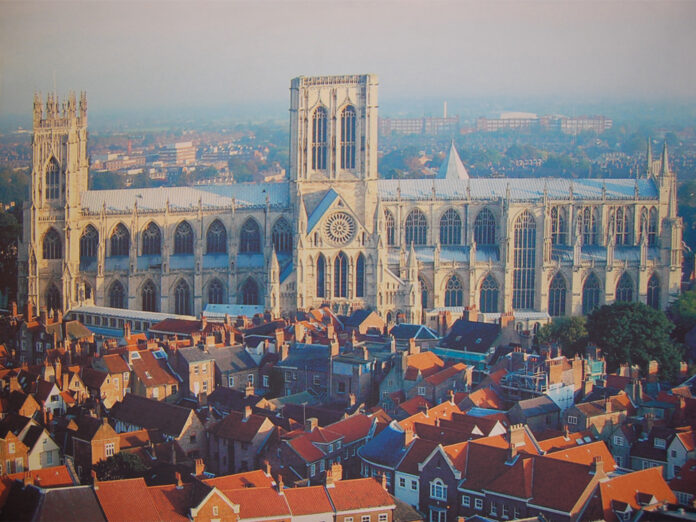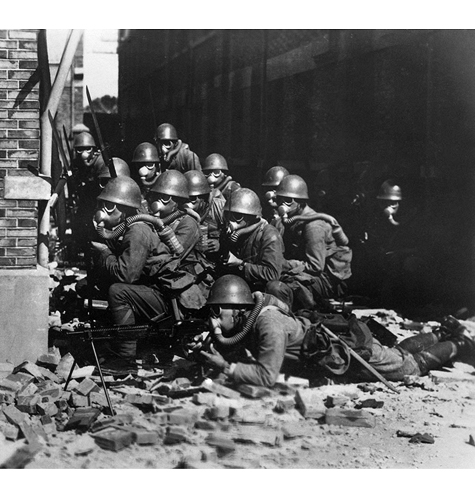Introduction An important trade and cultural city of the north of England, throughout the Middle Ages, York was an early Christian center. Its first Cathedral (dating back to 627) was destroyed by fire in 1137. The current cathedral was built over a 250 year period from 1220 to 1472, when it was officially consecrated. The ancient capital of the kingdom of Northumbria is the seat of the Cathedral and Metropolitan Church of St Peter in York (usually called York Minster), the largest religious building in the Western World; dominated by three towers, one of them 200 feet high. The cathedral is renowned for the purity of its architecture, the richness of its facades, the quality of its sculptures. Its dimensions are also considerable: its length is 518 feet, its choir height 102 feet. It has the widest nave in Europe. The context – When the Chapter of the Cathedral of St. Peter signed a contract with the stonecutters, hewer, and layer masons for the reconstruction of the building in 1370, England was under the rule of King Edward III; who had decided in 1361 that Norman-French would no longer be the official language of the kingdom. It is the time of the Hundred Years War (1337-1453). Edward declared himself as the natural sovereign of the kingdom of France in 1369 provoking the French to war. On the other side of the Channel, Charles V (1338-1380) called “The Wise”– whose father sold Aquitaine and various other French possessions to the King of England after the defeat of Poitiers (1356) – sought to restore and strengthen his Kingdom. The document – Titled York Minster Masons’ Ordinances, it is part of a series of manuscripts written on parchment which are presently held by the library of the Cathedral; and was written in old English; as reproduced in The Fabric Rolls of York Minster, a book published in 1859, with this mention: “On the 31st of October, 1370, Master Robert de Patrington, and twelve other masons, came before the Chapter, and swore to observe these rules, in the following term: Lordes, if it be your wyles, we grant for to stand at our werkes truly at our power,” etc. Modern transcription from Old English. The Text It is ordered by the Chapter of the Church of Saint Peter of York that all Masons that shall work in the works of the same Church of Saint Peter shall, from Michaelmas day [September 29] to the first Sunday of Lent, be each day in the morning at their work in the lodge (1), which is provided for the Masons at work within the area at the side of the aforesaid church, at as early an hour as they can clearly see by daylight to work. And they shall stand there faithfully working at their work all day after that, as long as they can clearly see to work, if it is a full day of work; otherwise until high noon is struck by the clock, when a holiday falls at noon, except within the aforesaid time between Michaelmas and Lent; and at all other times of the year they may dine before noon if they wish, and also eat at noon where they like, so long as they shall not remain away from their work in the aforesaid lodge, at any time of the year, at dinner time, more than such a short time that no reasonable man shall find fault with their remaining away. And in the time of eating at noon they shall, at no time of the year, be absent from the lodges, nor from their aforesaid work, over the space of an hour; and after noon they may drink in the lodge, and for their drinking time, between Michaelmas and Lent, they shall not cease nor leave their work beyond the space of time that one can walk half a mile (2). And from the first Sunday of Lent until Michaelmas they shall be in the aforesaid lodge at their work at sunrise and remain there truly and carefully working upon the aforesaid work of the church, all day, until there shall be no longer than the time that one can walk a mile before sunset, if it be a work day, otherwise until the time of noon, as was said before; except that they shall, between the first Sunday of Lent and Michaelmas, dine and eat as beforesaid, after noon in the aforesaid lodge. And they shall not cease nor leave their work in sleeping time exceeding the time in which one can walk a mile, nor in drinking time after noon beyond the same time. And they shall not sleep after noon at any time except between Saint Elemnes [probably May 3] and Lammas [August 1] (3); and if any man remain away from the lodge and from the work aforesaid, or commit offense at any time of the year against this aforesaid ordinance (4), he shall be punished by an abatement of his wages, upon the inspection and judgment of the Master Mason. And all their times and hours shall be governed by a decree established therefore. It is also ordered that no Mason shall be received at work on the work of the aforesaid church unless he is first tested for a week or more as to his good work; and if after this he is found competent for the work, he may be received by the common assent of the Master and the keepers of the work and of the Master Mason, and he must swear upon the book that he will truly and carefully, according to his power, without any kind of guile, treachery, or deceit; maintain and keep holy all the points of this aforesaid ordinance in all things that affect or may affect him, from the time that he is received in the aforesaid work, as long as he shall remain a hired Mason at the work on the aforesaid work of the church of Saint Peter and that he will not go away from that aforesaid work unless the Masters give him permission to depart from the aforesaid work. And let whoever goes against this ordinance and breaks it against the will of the aforesaid chapter have God’s curse and Saint Peter’s. NOTES 1. – The word Lodge does not refer here to a chamber, a shelter or a cabin, but to the building site of the cathedral. 2. – Curiously, the time to walk a mile (about twenty minutes) or a half-mile (about ten minutes) becomes the time measurement of work or rest. 3. – Lammas Day used to be in England, in medieval times, the feast day of the new bread, made with the wheat harvest which had just taken place. That same day, August 1, was celebrated as the feast of St. Peter in chains – a feast day inspired by the Acts of the Apostles (12: 7), when an angel released the imprisoned Peter from his chains. 4. – Masonic historians usually write about the York Ordinances, using the plural, when the original text itself is presented as being “one” Ordinance.
Ordinanza della Cattedrale di York (1370)
Pubblicazione gratuita di libera circolazione. Gli Autori non sono soggetti a compensi per le loro opere. Se per errore qualche testo o immagine fosse pubblicato in via inappropriata chiediamo agli Autori di segnalarci il fatto è provvederemo alla sua cancellazione dal sito










